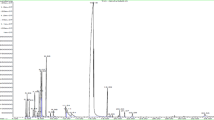Abstract
Both essential oils of fresh and air-driedAsarum caulescene (Maxim.) were analyzed by GC-MS in three different polarities. The results show that thirty-four components were identified in the oils, and main compounds of both oils were β-pinene (7.63% vs. 20.72%), 2-carene (8.94% vs. 7.99%), β-phellandrene (7.80% vs. 14.39%), 1,8-cineole (8.91% vs. 13.29%) and germacrone (46. 64% vs. 6.64%), however, the content of monoterpene hydrocarbons (30.29% vs. 52.30%) and oxygenated sesquiterpenes (47.69% vs. 10.65%) of both oils was different. The antimicrobial activity of the oil was evaluated against 3 fungi and 11 bacteria including 7 clinical isolated strains. Our results showed that both oils presented a broad antimicrobial spectrum, and compared with the essential oil from fresh herb, the extracted oil from dried herb had better antimicrobial activity, its minimum inhibitory concentration (C m) values of dried herb were 0. 16–2.5 g/L and lowest minimum bactericidal concentration (C m) values was 0.31 g/L.
Similar content being viewed by others
References
Qu Shuyan, Wu Yingjie. The Anti-Inflammatory Effect of “Xixin” [asAsarum heterotropiodes F. Schm. var. mandshuricum (Maxim) Kitag] Oil [J].Acta Pharmaceutica Sinica, 1982,17:12–16 (Ch).
Jiangsu New Medical College,Dictionary of Chinese Materia Medical [M]. Shanghai: Science and Technology Press of Shanghai, 1993:1477–1481 (Ch).
Wuhan Plant Graduate School of Chinese Academy of Sciences.Flora Hubeiensis [M]. Wuhan: Science and Technology Press of Hubei, 2001:204–205 (Ch).
Kim S J, Zhang Chenggao, Lim J T. Mechanism of Anti-Nociceptive Effects ofAsarum sieboldii Miq. Radix: Potential role of Bradykinin, Histamine and Opioid Receptor-Mediated Pathways [J].Journal of Ethnopharmacology, 2003,88:5–9.
Endo J, Ogino T, Nagasawa M. Studies on the Volatile Oil ofAsarum caulescens [J].Yakugaku Zasshi, 1972,92(7):874–878.
Endo J, Nagasawa M. Studies on the Essential Oil ofAsarum caulescens. II [J].Yakugaku Zasshi, 1974,94:1574–1579.
Endo J. Studies on the Essential Oil ofAsarum caulescens. III [J].Yakugaku Zusshi. 1975,95:1321–1326.
Endo J. Studies on the Essential Oil ofAsarum caulescens IV [J].Yakugaku Zasshi, 1977,97:393–398.
Xu Zhiling, Pan Jiongguang, Zhu Qichang,et al. GC/MS Analysis of Volatile Oils from ChineseAsarum Species. III [J].Zhong Yao Tong Bao, 1986,11:46–49 (Ch).
Eloff J N. Which Extractant Should be Used for the Screening and Isolation of Antimicrobial Composition from Plants? [J].Journal of Ethnopharmacology, 1988,60:1–8.
Adams R P.Identification of Essential Oils Components by Gas Chromatography/Quadrupole Mass Spectroscopy, USA [S]. Illinois: Allured Publishing Corporation, 2001.
National Committee for Clinical Laboratory Standards.Performance Standards for Antimicrobial Disk Susceptibility Test: Sixth Approved Standard M2-A6 USA [S]. Wayne: NCCLS. 1997.
National Committee for Clinical Laboratory Standards.Performance Standards for Antimicrobial Susceptibility Test: Ninth International Supplement Approved Standard M100-S9, USA [S]. Wayne, NCCLS. 1999.
Bassole I H N, Quanttara A S, Nebie R,et al. Chemical Composition and Antibacterial Activities of the Essential Oils ofLippia chevalieri andLippia multiflora fromBurkina Faso [J].Phytochemistry, 2003,62:209–212.
Yu Jianqing, Lei Jiachuan, Yu Huaidong,et al. Chemical Composition and Antimicrobial Activity of the Essential Oil ofScutellaria barbata [J].Phytochemistry, 2004,65:881–884.
Jorge R M, Lurdes B C, Susana C M,et al. Composition and Antimicrobial Activity of the Essential Oils fromInvasive Species of theAzores, Hedychium gardnerianum andPittosporum undulataum [J].Phytochemistry, 2003,64: 561–565.
Tzakou O, Pitarokili D, Chinou I B,et al. Composition and Antimicrobial Activity of the Esential Oil ofSalvia ringens [J].Planta Medica, 2001,67:81–83.
Mourey A, Canillac N. Anti-Listeria Moncytogenes Activity of Essential Oils Components of Conifers [J].Food Control, 2002,13:289–292.
Xia Kejian, Ren Yuhong, Nie Lijuan,et al. The Synthesis and Application of β-Phellandrene [J].Journal of Nanchang University (Natural Science Edition), 2001,25:380–382 (Ch).
Zhao Yingjie, Jiang Yongjia, Liu Yanqi,et al. The Toxicity of Synthetic β-Phellandrene on Some Stored-Grain Insect Pests [J]. Journal of the Chinese Cereals and Oils Association. 1997, 12 1–124 (Ch).
Barel S, Segal R, Yashphe J. The Antimicrobial Activity of the Essential Oil fromAchillea fragrantissima [J].Journal of Ethnopharmacology, 1991,33:187–191.
Lattaoui N, Tantaoui-Elaraki A. Individual and Combined Oils [J].Rivista Italiana EPPOS, 1994,13:13–19.
Marino M, Bersani C, Comi G. Impedance Measurements to Study the Antimicrobial Activity of Essential Oils fromLamiaceace and Compositae [J].International Journal of Food Microbiology, 2001,67:187–195.
Xiao Chonghou.Chinese Medical Chemistry [M]. Shanghai: Science and Technology Press of Shanghai, 1997:450 (Ch).
Trülzsch K, Rinder H, Trěek J,et al. “Staphylococcus pettenkoferi,” a Novel Staphylococcal Species Isolated from Clinical Specimens [J]Diagnostic Microbiology and Infectious Disease, 2002,43: 175–182.
Author information
Authors and Affiliations
Corresponding author
Additional information
Foundation item: Supported by the National Natural Science Foundation of China (30370366) and the Research Foundation for the Doctoral Program of Higher Education
Biography: ZHU Shunying (1975-), female, Ph. D. candidate, research direction: biochemistry and molecular biology
Rights and permissions
About this article
Cite this article
Shunying, Z., Yang, Y., Huaidong, Y. et al. Chemical composition and antimicrobial activity of essential oil ofAsarum caulescene . Wuhan Univ. J. Nat. Sci. 11, 699–703 (2006). https://doi.org/10.1007/BF02836693
Received:
Issue Date:
DOI: https://doi.org/10.1007/BF02836693



